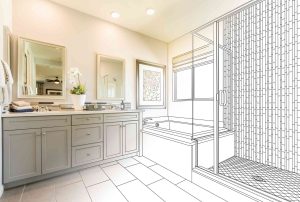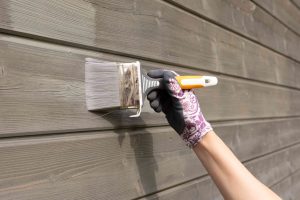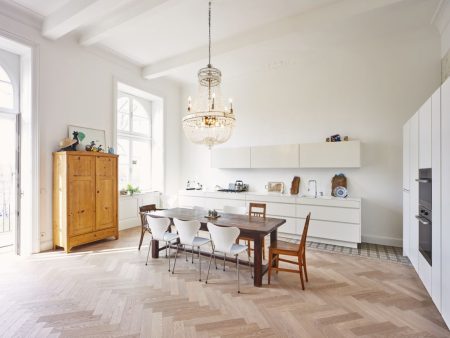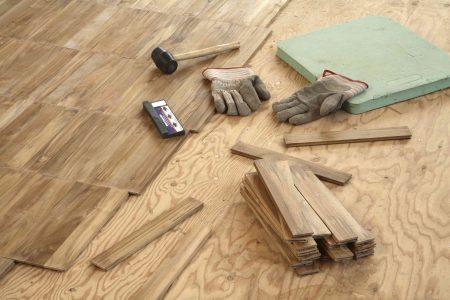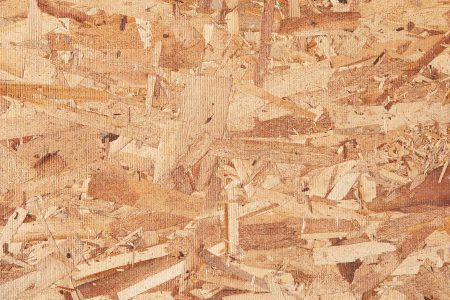When you’re after durable, economical, or attractive flooring that’s easy to install yourself, you’re often left deciding between two top contenders: vinyl vs laminate flooring. They’re equally easy to install, cost about the same, and they’re both attractive. To the untrained eye, it seems the only difference is the name.
So, is there any difference? Yes. While vinyl and laminate seem similar on the surface, there are several crucial differences like moisture resistance, durability, and maintenance, that will drastically influence your decision. Read on to learn the differences between laminate vs vinyl flooring, plus some pros and cons that will help you choose between the popular flooring options.
Watch Now: 7 Things You Should Know About Vinyl and Laminate Flooring
Vinyl vs. Laminate Flooring: Major Differences
The key difference between vinyl and laminate flooring is the materials they’re made from. Laminate flooring is comprised of several layers laminated together, including a wood fiberboard core. Vinyl flooring, while also available with several layers, is limited to synthetic materials.
Vinyl Flooring
| Item | Purpose |
| UV Acrylic Coating | Protects the floor from sun damage |
| Wear Layer | Protects against scratches |
| Print or Image Layer | The image or look of the flooring |
| PVC Layer | Provides stability and support |
| Core | The main body of the flooring made of PVC |
| Built-in Underlayment | Soft layer helps with uneven subfloors |
Common types of vinyl flooring include the following:
- Luxury Vinyl Planks (LVP)
- Luxury Vinyl Tiles (LVT)
- Sheet Vinyl
Vinyl flooring is a 100-percent synthetic material. In standard sheet vinyl and vinyl tiles, the base layer is usually fiberglass that’s coated in PVC and a plasticizer. The resulting sheet is printed and embossed with a surface print layer. Over this, multiple wear layers are applied, along with a layer of no-wax polyurethane.
Not all plank vinyl flooring has built-in underlayment, though it’s found on an increasing number of vinyl floors. With vinyl plank flooring, the core layer is a thicker, multi-layer PVC. Luxury vinyl flooring comes in planks or tiles that interlock side-to-side to form a floating floor. The overall thickness for vinyl flooring ranges from 1.5 mm for sheet vinyl to 5 mm for luxury vinyl planks.
What Is a Floating Floor?
A floating floor is a floor system comprised of components that lock together, forgoing the use of nails, glue, or other fasteners. A floating floor rests on top of, but does not physically attach to the subfloor material.
Laminate Flooring
| Item | Purpose |
| Wear Layer | Clear aluminum oxide layer to protect floor against scratches |
| Print Layer | The image or look of the flooring |
| Core Layer | The main body of the floor, made of highly compressed wood fibers |
| Built-in Underlayment | Soft layer helps with uneven subfloors |
Laminate flooring, which is limited to planks, is similar to LVP in its look and method of installation. The critical difference is that its core is made from wood byproducts bonded with resins. The top surface is a hard, transparent plastic wear layer that covers the printed design layer. The overall thickness for laminate flooring planks ranges from 6 mm to 12 mm.
As with plank vinyl, a built-in underlayment is an option. Built-in underlayment is increasingly popular as DIYers decide they want to eliminate the step of rolling out separate underlayments.
Appearance
Laminate is the best flooring option for appearance. Both laminate and vinyl flooring are generally comparable in appearance, but more laminate options closely mimic hand-scraped hardwood, stone, ceramics, and other materials.
Laminate Flooring
Laminate flooring’s thick top layer allows for deep, realistic three-dimensional embossing on its surfaces, with accurate images of the natural material being portrayed.
Vinyl Flooring
Vinyl flooring isn’t known for its realistic looks but LVP is the most realistic of the bunch. Thicker solid-core vinyl flooring will look more like wood since deeper embossing is possible.
Cost
Vinyl and laminate flooring are competitively priced. However, sheet vinyl is often easier on the wallet. Most laminate and vinyl options are less expensive than natural hardwood, engineered wood, and many types of ceramic or porcelain tile, which make them popular flooring alternatives for those looking to save money.
Laminate Flooring
Laminate flooring ranges from about $1.00 per square foot for 7 mm-thick planks to about $5.00 per square foot for 12 mm-thick planks.
Vinyl Flooring
Vinyl flooring can cost as little as $1.00 per square foot for thin, glue-down vinyl flooring. Vinyl costs rise to around $5.00 per square foot for LVP, and premium brands will cost even more. For those looking to save as much money as possible, budget-friendly sheet vinyl options are available for as low as $0.65 per square foot.
Water Resistance
Vinyl flooring is more water-resistant than laminate. In fact, all types of vinyl flooring are considered waterproof because sheet vinyl, LVT, and LVP are made with materials that are 100% waterproof. However, seams between planks and tiles can allow water to reach the subflooring if enough liquid is present. In full bathrooms and damp locations such as basements, vinyl flooring materials excel over laminate materials.
Laminate Flooring
Virtually all laminate flooring uses a fiberboard core. Because this core is a wood product, it will soften and swell if exposed to water. The fiberboard core won’t resume its original dimensions after it has dried. Additionally, the wear and design layers sometimes peel away after the core has become waterlogged. Severely water-damaged laminate flooring usually needs to be replaced; it cannot be fixed.
Properly installed laminate flooring, with tight seams and good baseboards or moldings, can tolerate pooled water for a short period. For family bathrooms or other areas where standing water is likely, traditional laminate flooring is a poor choice. However, there may be newer laminate materials that are better at resisting water.
Vinyl Flooring
Modern vinyl flooring is waterproof. While older forms of vinyl flooring may have a fabric or felt backing that isn’t waterproof, newer iterations of vinyl flooring are made of 100% synthetic materials. Luxury vinyl flooring can be fully immersed in water for long periods, dried out, then reused, completely unaffected.
Warning
Just because a flooring material is waterproof doesn’t mean it offers protection to structural elements below. If possible, water should be removed immediately to avoid damage to the subfloor. Sheet vinyl that comes in 12-foot wide rolls often requires no seaming on smaller rooms, making it an excellent choice for a truly waterproof floor that protects the subfloor as well.
Heat Resistance
Neither vinyl nor laminate flooring is particularly heat resistant. Vinyl flooring won’t shrink or expand as drastically as laminate in extreme temperature fluctuations, but both materials somewhat tie in heat resistance since damage can be done to both under similar circumstances. You can also lay both materials over radiant heat flooring (provided you limit it to around 80 degrees Fahrenheit), but radiant heat may be a bit more effective under laminate flooring.
Laminate Flooring
Laminate flooring’s top layer could burn if you drop something extremely hot onto the surface. Additionally, laminate does not tolerate constant temperature changes in a room because it tends to expand and contract.
Vinyl Flooring
Like laminate, vinyl flooring can easily scorch if you drop something extremely hot on the surface. However, normal temperature fluctuations don’t affect vinyl flooring. Extreme ambient heat exposure can cause problems such as expansion and melted adhesive.
Care and Cleaning
Vinyl flooring is the easiest to thoroughly clean. While both laminate flooring and vinyl flooring are easy to keep clean, only vinyl flooring allows the entire span of cleaning methods, from sweeping with a dry broom to wet mopping.
Laminate Flooring
Laminate flooring is best cleaned first with dry methods, such as with a dry mop or broom. If you need to wet-clean laminate flooring, you should use only a damp mop that feels almost dry to the touch.
Vinyl Flooring
Vinyl flooring’s strongest feature is that it’s so easy to care for and clean. Vinyl flooring in good condition can be wet-mopped and, if necessary, vigorously scrubbed with safe cleaning products.
Durability and Maintenance
Vinyl is more durable than laminate flooring. Vinyl flooring is a supremely durable, low-maintenance flooring, thus the industry term resilient flooring. Vinyl flooring is even used in commercial applications, where durability and maintenance are high priorities.
Laminate Flooring
Laminate flooring is durable and low maintenance. However, laminate flooring’s many layers may eventually delaminate over time, especially if it’s exposed to water for too long. Once the laminate’s top wear layer is scratched or chipped, it cannot be repaired. Once delamination starts to happen, the top layers begin to peel up and allow water to enter the lower layers.
Vinyl Flooring
Vinyl flooring is a tough flooring material that will stand up to high traffic demands. Thin vinyl flooring has a slight advantage over thick vinyl flooring, which can potentially delaminate over time. With the thin flooring, delamination isn’t a concern because it’s a single cohesive layer of polyvinyl chloride (PVC). Thicker, more expensive plank vinyl flooring’s soft underlayment is the weak link in its layering system and has the potential to delaminate.
Installation
The ease of installation of vinyl vs laminate flooring is similar. Both materials have advantages and disadvantages when it comes to ease of installation. Vinyl or laminate planks are easier to DIY install than sheet vinyl. Vinyl needs fewer tools than laminate. Installing laminate flooring requires a saw and a certain skill level to use it correctly to cut down on the amount of waste.
Laminate Flooring
Laminate flooring uses a click-and-lock installation method, where the tongue of one plank is fitted into the groove of an adjoining plank at an angle. Then the first plank is folded down until it’s level with the other plank. This action draws the boards together and closes the seam. An ordinary circular saw or table saw equipped with a fine-tooth blade, or even a hand saw, is used to cut laminate planks.
Vinyl Flooring
Vinyl planks also use a click-and-lock method of installation. However, vinyl flooring planks can simply be cut with a utility knife. A score mark is first made, then the plank is bent back on itself and a second cut is made from the rear.
Sheet vinyl flooring does have its disadvantages: sheet vinyl can be a difficult material for DIYers to install. The material is large, heavy, and unwieldy. Plus, it can be hard to make complicated cutouts from sheet goods. If you are installing sheet vinyl, professional installation is often your best bet.
Lifespan
Laminate and vinyl flooring have similar lifespans if properly cared for. As long as laminate flooring is kept reasonably dry and is regularly cleaned, buyers may expect lifespans close to that of vinyl flooring.
Laminate Flooring
Laminate flooring warranties typically range from 10 to 25 years, but this is dependent on a rigorous maintenance schedule.
Vinyl Flooring
Warranties on luxury vinyl flooring often range up to 20 years.
Comfort & Sound
Both laminate and vinyl flooring can be quiet and comfortable to walk on. Laminate flooring products can feel and sound somewhat hollow underfoot when compared to the wood floors they are supposed to mimic. But when combined with either foam or felt underlayment, laminate flooring may be quieter, softer, and more comfortable to walk on.
Laminate Flooring
Though laminate flooring does not feel like wood, it does have a warm feeling, especially when coupled with premium-quality underlayment. You can commonly hear people walking on laminate if they are wearing heels.
Vinyl Flooring
Vinyl floors of all types can feel cold or hard on the feet, especially when they are installed over concrete or existing ceramic tile floors. But walking with heels on vinyl flooring is typically quiet.
Resale Value
Quality laminate flooring and vinyl flooring lend a comparable amount of value to a home. Neither brings the high-value prestige of solid hardwood, engineered hardwood, designer ceramic tile, or natural stone floors. At the same time, quality laminate or vinyl flooring usually will not put off prospective home buyers.
Laminate Flooring
Premium laminate flooring can lend extra resale value to a home, as long as it’s relatively new and in good condition.
Vinyl Flooring
Major brand luxury vinyl plank flooring will bring decent resale value to a home. However, cheap vinyl flooring will often be seen by buyers as a project-in-waiting once the house has sold.
Environmental Impact
Neither laminate nor vinyl flooring is significantly environmentally friendly. If using green building materials is important to you, laminate flooring has a small advantage, thanks to the natural wood content of the fiberboard core. Still, neither of these materials is especially environmentally friendly in the way that natural wood, linoleum, or bamboo floor coverings are.
Laminate Flooring
Some laminate flooring manufacturers offer products that qualify for LEED MR4 (Recycled Content) status. But laminate flooring still uses a plastic surface layer, and the melamine resins used in the creation of the core level are by no means green materials since they may off-gas chemicals.
Vinyl Flooring
Vinyl flooring has improved its green stature in recent years. Some vinyl flooring manufacturers now offer products that achieve a LEED credit EQ4.3 for Low-Emitting Material. Vinyl is a synthetic material that is known to produce toxic chemicals when burned. Vinyl does not decompose in landfills, and recycling it is usually not an option.
Stain Resistance
Laminate and vinyl flooring are both stain-resistant. Good quality modern vinyl flooring and laminate flooring both receive wear layers treated with properties that do an excellent job of resisting stains.
Laminate Flooring
The top layer of laminate flooring is a clear aluminum oxide layer that is superior for stain resistance.
Vinyl Flooring
Quality vinyl flooring is coated with a transparent urethane layer that provides excellent stain resistance.
Recommended Installation Areas
Vinyl can be installed throughout the home, while laminate should only be used in certain areas. So, is vinyl or laminate flooring a better option for your space?
Installation Areas: What Is Better?
Vinyl flooring outperforms laminate flooring in the area of water resistance, making it a go-to flooring material for areas that are prone to water and moisture exposure.
| Installation Areas | Laminate Flooring | Vinyl Flooring |
|---|---|---|
| Bathroom, Full or Partial | No | Yes |
| Powder Room | Maybe | Yes |
| Kitchen | Maybe | Yes |
| Dining Room | Yes | Yes |
| Living Room | Yes | Yes |
| Bedroom | Yes | Yes |
| Home Office | Yes | Yes |
| Mudroom | No | Yes |
| Basement | No | Yes |
Which Is Better?: Laminate or Vinyl Flooring
When it comes to laminate vs vinyl flooring, one is not any better or worse than the other. Vinyl flooring is best for laundry rooms, wet bathrooms, and mudrooms. If you are installing flooring in those rooms, you’ll probably want to choose vinyl flooring simply based on moisture resistance. For dry areas, laminate flooring works well and has a generally better appearance. Buyers usually will find more style options with laminate flooring over vinyl flooring.
Top Brands
Laminate Flooring
- Dream Home (Lumber Liquidators / LL Flooring)
- Pergo
- QuickStep
Vinyl Flooring
- Armstrong
- Mannington
- Shaw
-
What is the difference between laminate and vinyl flooring?
The main difference between laminate and vinyl flooring is the materials they’re made of. Vinyl is 100% synthetic, while laminate uses a fiberboard core constructed of wood byproducts. Thus, laminate flooring is not waterproof, while vinyl flooring is 100% waterproof. Both floorings are stain-resistant and offer the option of underlayment, but are built a bit differently.
-
What is cheaper, laminate or vinyl?
Vinyl and laminate flooring are similarly priced, though sheet vinyl can sometimes be found slightly cheaper. Luxury vinyl options can be much more expensive than laminate.
-
Which lasts longer, vinyl or laminate?
Laminate and vinyl flooring have similar lifespans when properly cared for, though vinyl flooring is considered more resilient, which may ensure a longer lifespan for many users.
-
Which is better for pets, vinyl or laminate flooring?
Vinyl flooring is superior to laminate when it comes to pets. This is due to vinyl’s 100% synthetic constructions, which makes it waterproof.
-
Which is more scratch resistant, laminate or vinyl?
Vinyl flooring is more scratch resistant than laminate flooring, but LVT and LVP may be more prone to top-layer tearing.
Read the full article here



